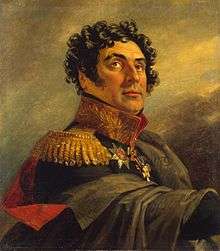Peter Ivanovich Ivelich
Count Peter Ivanovich Ivelich or Peter Ivelich IV [2](Russian: Пётр Ивелич,[3]also known as Pyotr Ivanovich Ivelich IV; 1772 - after 1851) was a Serb Montenegrin who ranks among the most important Russian generals who fought during the Napoleonic invasion of Russia. His portrait was added to the Military Gallery of the Winter Palace along with other participants in the Patriotic War of 1812.[4]His uncles are count Marko Ivelich, major-general Ivan Ivelich and colonel Simeon Ivelich (hence, Peter Ivelich IV).
Count Peter Ivanovich Ivelich | |
|---|---|
 | |
| Born | 1772 Risan, Venetian Albania |
| Died | after 1850 Russia |
| Allegiance | |
| Service/ | Army |
| Years of service | 1788–1815 |
| Rank | Major General |
| Wars | Russo-Turkish War (1787-1792) War of the Fourth Coalition Finnish War Patriotic War of 1812
|
| Awards | Order of St. George 4th class, Order of St. Vladimir 3rd class, Order of St. Anna 1st class |
Biography
Ivelich was born at Risan in the Venetian Republic (now Montenegro) in 1772.
As a captain in the army of the Venetian Republic, he transferred to the Imperial Russian military service on 15 June 1788 as a lieutenant in the Nasheburg Infantry Regiment. In three months he was promoted to captain on 9 September 1788 for recruiting 186 Slav volunteers, and transferred to the Finnish Chasseurs Corps and, on 25 March 1793, to the Shirvan Infantry Regiment. He was promoted to the rank of major and appointed the commander of the Shirvan Musketeer Regiment on 17 January 1799.[5]
From 22 April 1799, with the rank of lieutenant colonel, he took part in the Russo-Turkish War. He was promoted to colonel on 10 August 1800. He fought the French in Austria (1805) and Prussia (1807). On 24 August 1806, he was appointed chef of the Brest Musketeer Regiment. He participated in the Battle of Lemo against the Swedes (1808-1809); based on merit, on 18 October 1808, he was elevated to major general.[5]
In 1812, as a major general, he participated in battles at Vitebsk, Smolensk, and Valutino. In the Battle of Borodino,[6]he sustained bullet wounds in the right shoulder and on the right side. After recovery, he participated in more battles. In the campaign of 1813, he fought near Dresden and Bautzen. [5]
He participated in the battles of the Great Patriotic War. Between May 1813 and February 1815 he was put on a medical recovery list. In 1815 he became Brigade Commander in the 17th Infantry Division.
On 12 December 1816 (Old Calendar), he took his military retirement on medical grounds, left the service with the uniform and full salary,[5]and joined uncle Marko Ivelich in a business venture with the Russian-American Company.[7]
He died at Tara, Imperial Russia, sometime after 1850.
Ranks, decorations, and awards
Russian Ranks
- Lieutenant - 15 June 1788
- Captain - 9 September 1788
- Major - 17 January 1799
- Lieutenant Colonel - 22 April 1799
- Colonel - 10 August 1800
- Major General - 18 October 1808
Decorations and awards
See also
- Peter Mikhailovich Kaptzevich
- Andrei Miloradovich
- Jovan Horvat
- Nikolay Depreradovich
- Ivan Adamovich
- Ilya Duka
- Ivan Lukačević (soldier)
- Jovan Tekelija
- Matija Zmajević
- Marko Ivanovich Voinovich
- Jovan Albanez
- Jovan Šević
- Simeon Piščević
- Semyon Zorich
- Georgi Emmanuel
- Anto Gvozdenović
- Mikhail Miloradovich
- Pavle Julinac
- Dmitry Horvat
- Nikolai Dimitrievich Dabić
- Nikolai Kuznetsov (admiral)
References
- Adapted and translated from the existing Russian Wikipedia article at Ивелич, Пётр Иванович
- The State Hermitage. Western European painting. Catalog. 2nd Volume
- ИнфоРост, Н. П. "ГПИБ | Зварыкин Федор васильевич ; Ивелич 2 Петр Иванович, Граф ; Игнатьев Дмитрий Львович ; Иловайский 1 Алексей Васильевич". elib.shpl.ru.
- "Генералитет российской императорской армии и флота". rusgeneral.ru.
- "Ивелич, Пётр Иванович". September 13, 2019 – via Wikipedia.
- "Ивелич Пётр Иванович / Персоны / Война 1812 года. Биографический справочник". www.brdn.ru.
- "French : Russian : Order of Battle : Ordre de Bataille : Borodino 1812". napoleonistyka.atspace.com.
- Okunʹ, Semen Bent͡sionovich (1979) [1951]. The Russian-American Company. Harvard University Press. OCLC 250170640.